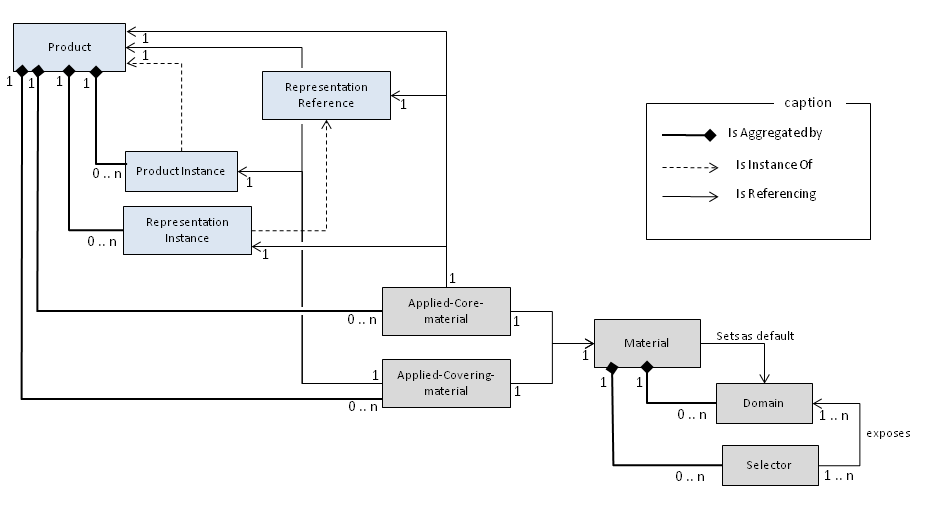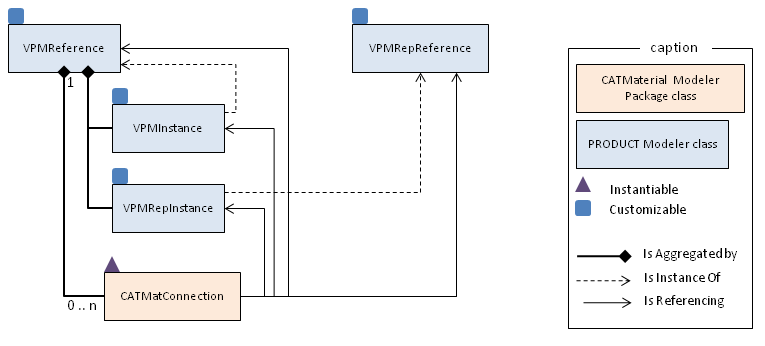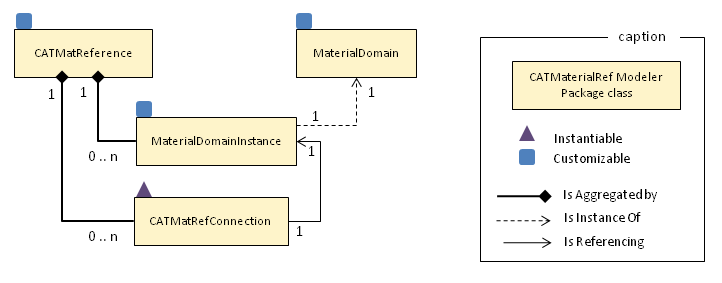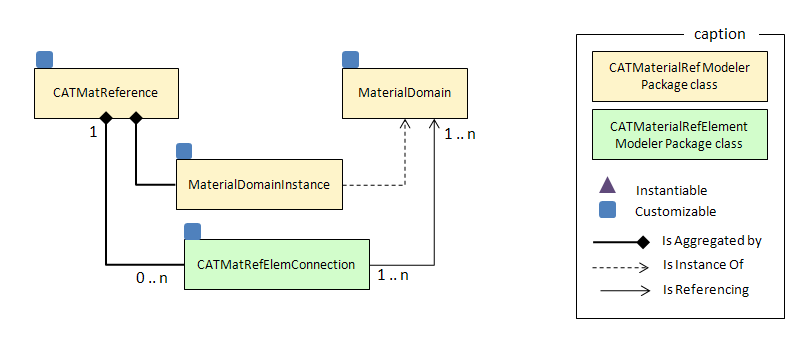
Material Modeler Description & Customization |
| Technical Article |
|
This article presents the Material modeler, and explains how to customize it. |
This section first presents the objects representing the Material modeler. Then it describes how this object model view has been translated towards PLM objects based on PLM Core Modeler objects. You will see the description of each PLM package defining these PLM objects.
Material modeler is composed of two main parts: objects used to define a material and its properties, and the object to model the fact that an entity of the modeler PRODUCT is 'made of' or 'covered by' a given material.
This is summarized in the following UML schema:
 |
Material modeler is described through 3 modeler PLM packages :
Applied-Core-Material and Applied-Covering-Material are implemented using the same class of CATMaterial PLM Package: CATMatConnection. It is the V_discipline attribute of CATMatConnection that is used to sub-type Applied-Core-Material and Applied-Covering-Material.
 |
| PLM Core Class | Specialized as |
|---|---|
| PLMConnection | CATMatConnection |
Refer to the modeler PLM package documentation [1] for a complete view of its contents included 3DXML support.
Material is implemented using the CATMatReference class of the PLM Package CATMaterialRef.
Domain is implemented using the MaterialDomain and MaterialDomainInstance classes of the PLM Package CATMaterialRef
The class CATMatRefConnection is used to flag one of the domain as the 'default' one (when this is allowed by the domain's type).
 |
| PLM Core Class | Specialized as |
|---|---|
| PLMCoreReference | CATMatReference |
| PLMCoreRepReference | MaterialDomain |
| PLMCoreRepInstance | MaterialDomainInstance |
| PLMConnection | CATMatRefConnection |
Refer to the modeler PLM package documentation [1] for a complete view of its contents included 3DXML support.
Selector object is implemented using the CATMatRefElemConnection class of the PLMPackage CATMaterialRefElement. It uses the relations hold by the connection object to expose features in Domains.
 |
| PLM Core Class | Specialized as |
|---|---|
| PLMConnection | CATMatRefElemConnection |
Refer to the modeler PLM package documentation [1] for a complete view of its contents included 3DXML support.
This section lists and describes the PLM Opening ID implemented by the following PLM classes of the XXX modeler.
| PLM Opening ID | Script Contents |
|---|---|
| ID1 | script description per operation |
| ID2 | script description per operation |
<Explanations:
| PLM Opening ID | Script Contents |
|---|---|
| ID1 | script description per operation |
| ID2 | script description per operation |
<Explanations:
Customization first deals with the modeler PLM package customization [2]. It consists in to create a new package containing new PLM classes for each "Customizable" PLM class of the modeler PLM package. Then, you should take into account the UI masks creation to create either a new security mask file, or to update the default one [3]. Finally, you can integrate your own business logic on each new PLM classes by implementing provided PLM opening ID [4].
This part consist in to create a new package when the modeler PLM package must be customized.
CATMaterialRef must be partially customized.
| PLM Class Name | To Be Customized | Remarks |
|---|---|---|
| CATMatReference | Yes | It is strongly advised to use as IdentifierSet the sole attribute PLM_ExternalID |
| MaterialDomain | Yes | It is strongly advised to use as IdentifierSet the sole attribute PLM_ExternalID |
| MaterialDomainInstance | Yes | |
| CATMatRefConnection | No |
The advice about IdentifierSet is aimed at improving data exchanges between a customized site and a site using the pre-defined VPM Team customization.
CATMaterialRefElement must be customized.
| PLM Class Name | To Be Customized | Remarks |
|---|---|---|
| CATMatRefElemConnection | Yes |
When a PLM attribute is defined (inside modeler PLM package) some features like its editability criteria, mandatory /optional option, can be overwriten by UI mask. You can say this PLM attribute is not writable in Query context, this PLM attribute is mandatory in Create context, this user PLM attribute is not never visible and so one. A set of UI masks form a security mask file. We say security mask because it is associated with these files security information. For a people, and a given context can be associated a security mask.
For each customized Modeler PLM package, at least one UI mask file must be created (for the default security mask ), since it must contain the new PLM Attributes. When you use the tool to create a customization, a default UI mask file is provided taken into account the added PLM attributes. You can modify the default file to introduce your change .
If you want create a new security mask file, you should provide a UI mask for all the "AsIs" modeler PLM packages and for each customization of the "Customizable" modeler PLM package.
To create a UI mask you should respect the following rules :
You can yourself integrate your business logic for each customization of:
| PLM Opening ID | Remarks |
|---|---|
| PLMImportExportAttributesValuation | |
| PLMIdentificationInitialization |
| PLM Opening ID | Remarks |
|---|---|
| PLMImportExportAttributesValuation | |
| PLMIdentificationInitialization |
| [1] | |
| [2] | Modeler PLM Package Concepts and Customization Principles |
| [3] | UI Mask Concepts and Customization Principles |
| [4] | Business Logic Concepts and Customization Principles |
<Each package name in the reference table is an external name, but the links refer to a file whose the name is build with the package's internal name >
| Version: 1 [Oct 2008] | Document created |